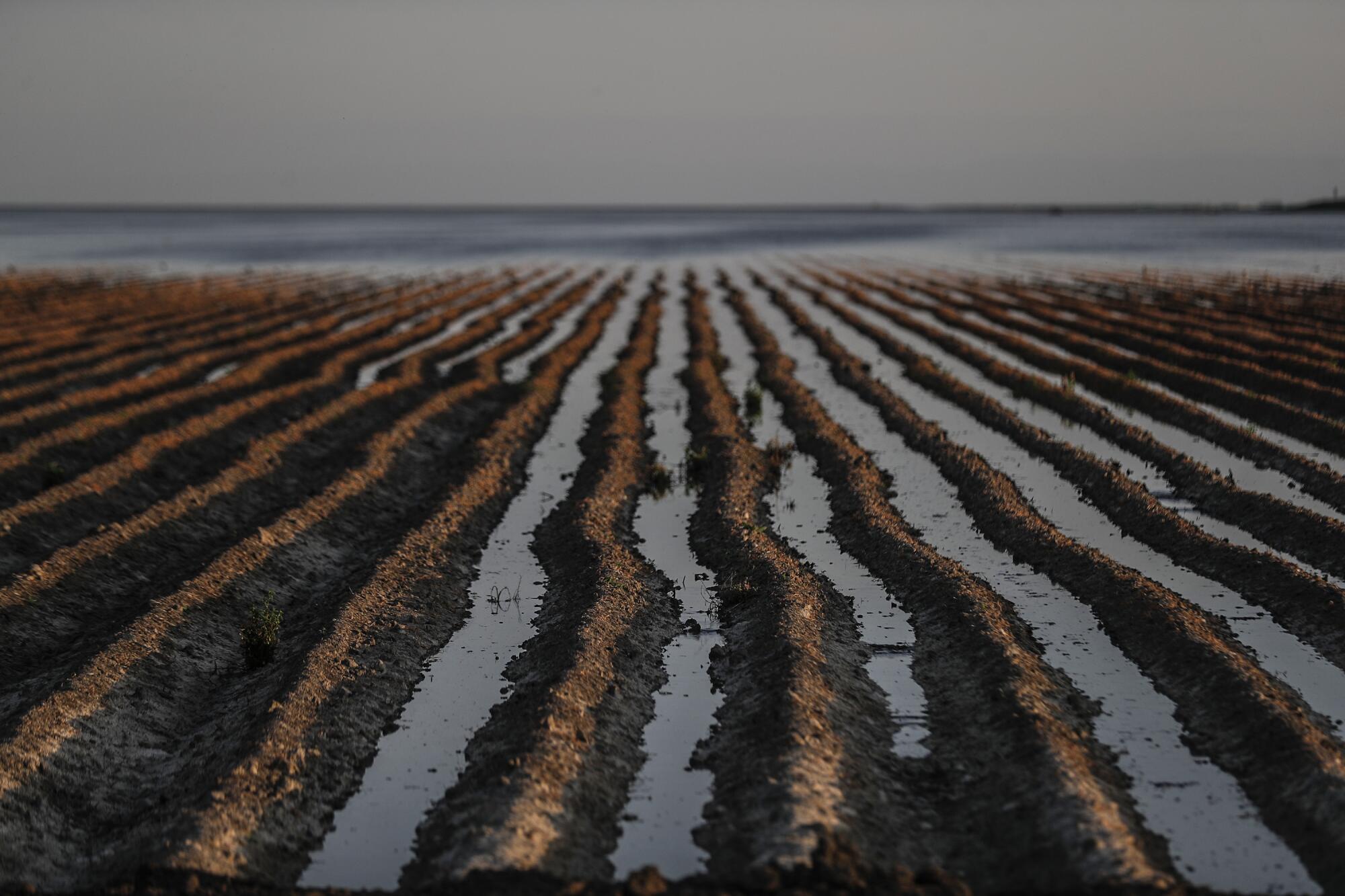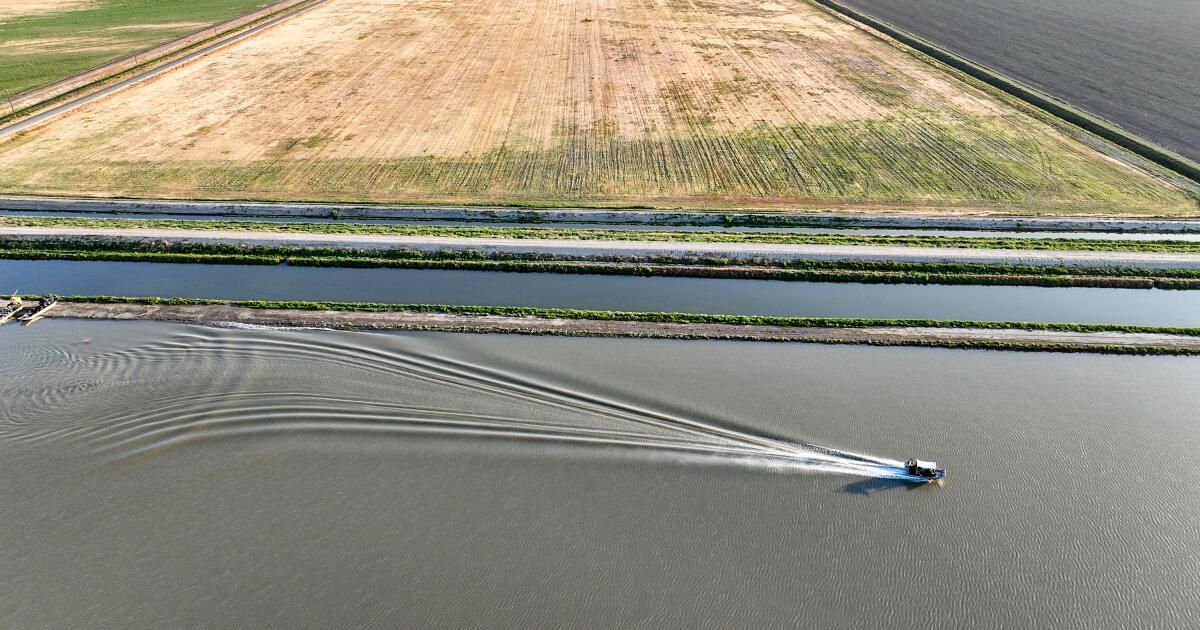California water regulators took the unprecedented step of cracking down on one of the state's major agricultural regions for failing to take action to curb excessive pumping of groundwater by farmers, which has caused Water is falling rapidly and is causing the earth to sink.
The State Water Resources Control Board voted unanimously Tuesday to place the Tulare Lake Basin on “probation” status for failing to take sufficient steps to address chronic overpumping.
Aggressive and impactful reporting on climate change, the environment, health and science.
Falling groundwater levels have caused the ground to sink up to 6 feet in parts of the area over the past decade, and state officials have determined that a local plan to manage groundwater would allow the free fall to continue. They say that without stronger measures, hundreds of domestic wells are at risk of going dry.
It is the first time that California officials have used their authority to intervene in a community to impose stronger measures to curb groundwater depletion, as required by the Sustainable Groundwater Management Act (SGMA). in English) of the state, which dates back a decade.
“The goal here is to prepare people for success at the local level. We recognize that this is a really difficult job,” board member Laurel Firestone said before the vote. “When these decisions are so big and so difficult, sometimes it falls to the state to be the backup, and that's what I think we should do.”
Now that the area in the southern San Joaquin Valley has been placed on probation, large agricultural landowners will have to start reporting to the state how much water they draw from wells and pay fees based on their use.
The vote came at the end of a daylong meeting in Sacramento where farmers and representatives of local groundwater agencies urged the state water board to postpone intervention and give them more time to improve their local plan to move toward sustainable management. of groundwater.
Newsletter
Towards a more sustainable California
Get Boiling Point, our newsletter exploring climate change, energy and the environment, and be part of the conversation and the solution.
You may occasionally receive promotional content from the Los Angeles Times.
Farmer Doug Freitas told the board that the “excessive costs” will severely harm the farming community.
“Let us not allow the SGMA to kill, steal and destroy our lives,” Freitas said. “We, the people of this great state of California, would like to ask for more time to resolve these issues that need to be corrected.”
But board members said the state must intervene.
“The goal here is not to be punitive in the least,” said Joaquín Esquivel, board president.
“The reality is that probation is a step,” Esquivel said. “It's a process that ultimately has to do with local control.”

The State Water Resources Control Board's action is the first of its kind to address excessive groundwater pumping.
(Robert Gauthier / Los Angeles Times)
The Tulare Lake Basin is one of six areas in the San Joaquin Valley where the state has deemed local groundwater plans inadequate.
Under the 2014 state groundwater law, the basin's five local groundwater agencies must develop a plan to reduce pumping and curb chronic declines in groundwater levels by 2040.
But last year state water board staff recommended test status after discovering that the local plan did not include adequate measures to stop declining water levels and the related problem of land subsidence, among other problems.
Land has been sinking rapidly in areas around the city of Corcoran. The levees protecting Corcoran from flooding have had to be raised twice in the past decade, including last year when long-dry Tulare Lake reappeared on thousands of acres of farmland.
“There have been and continue to be really serious impacts on people,” Firestone said. “While changing and reducing pumping will have really serious impacts, doing nothing and continuing with the status quo has already had, and will continue to have, real impacts on communities, community infrastructure and livelihoods. And I think we are doing this because we all recognize that we have no choice.”
The decision represents the first phase of what could be a two-step state intervention process. State officials say they will work with the five local groundwater sustainability agencies to gather data and develop a workable plan.
The area will be in testing status for one year. Most well owners will need to start reporting how much they use, while those pumping more than 500 acre-feet per year will need to install meters on their wells. Well owners will also be required to pay the state $300 per well plus a pumping fee of $20 per acre-foot, a measure intended to cover costs related to the state's intervention.
“The first step we are taking is to obtain information and understand what is happening. That’s what probation means,” Firestone said. “We have to understand where the wells are and how much is being pumped.”
The goal, state officials said, is to work with local agencies to improve their plan so that state intervention is no longer necessary.
But if local agencies fail to address deficiencies in their groundwater plan, the state water board would move to a second phase that would involve stronger intervention. State officials could then consider whether to impose restrictions on pumping or impose fines when pumping exceeds limits.
State officials estimated that the local agencies' plan Allow continued declines in groundwater levels. That would put about 700 national wells at risk of going dry.
“Groundwater supplies in the Tulare Lake Basin are clearly at risk, and today we are acting to protect this resource because communities depend on it for their basic needs, particularly drinking water,” Esquivel said. “Our goal remains for these basins to be managed sustainably at the local level, and we are committed to helping groundwater agencies achieve this by providing them with data, guidance and support as they improve their plans.”












